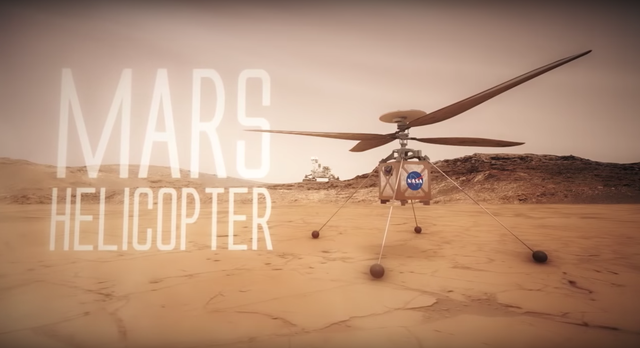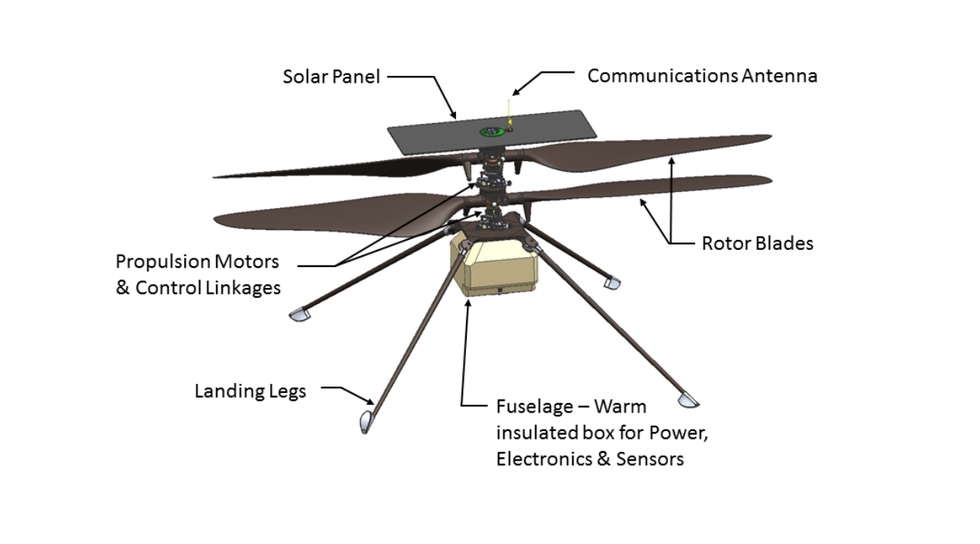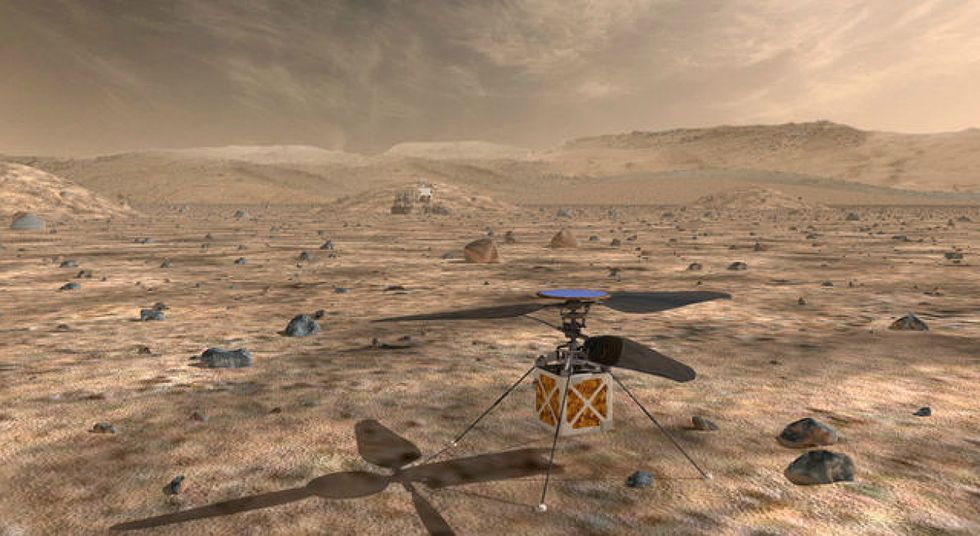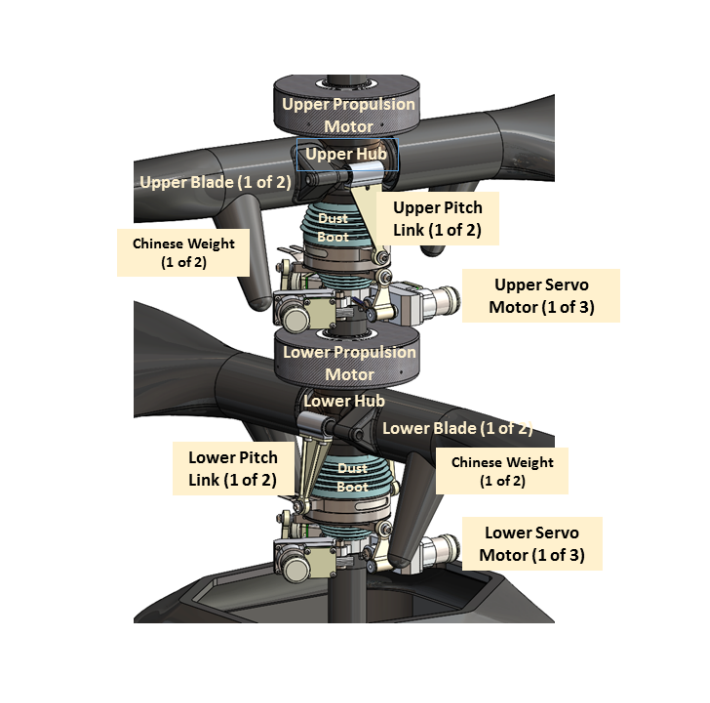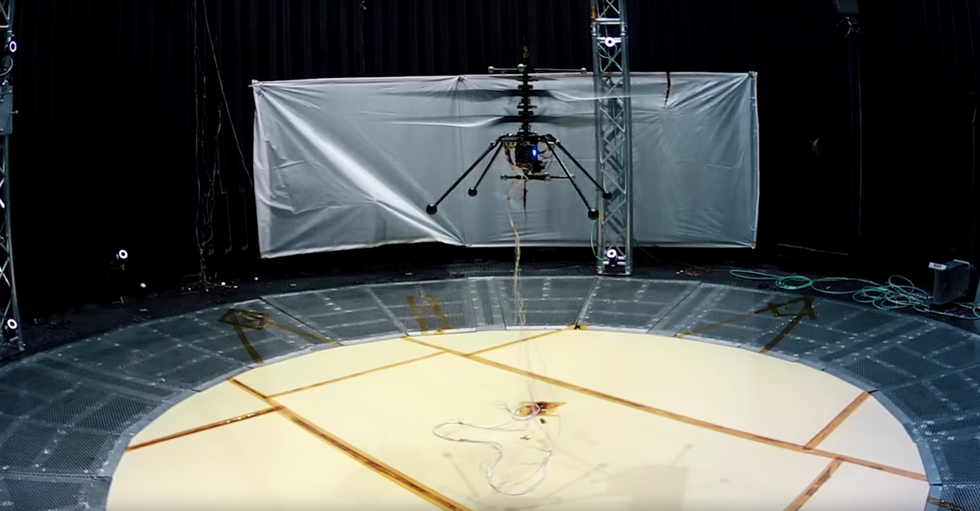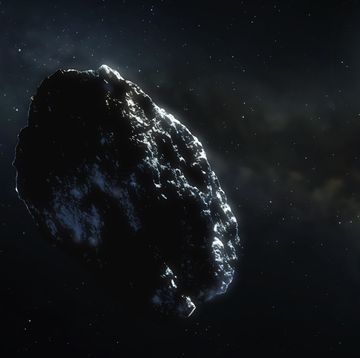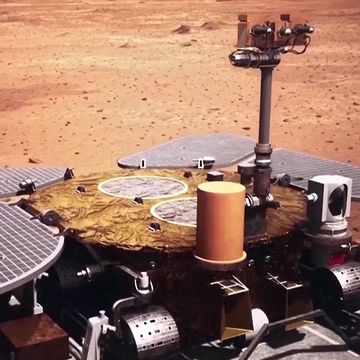To understand the monumental task of flying an aircraft on Mars, one needs to consider the atmosphere. The Red Planet's average atmospheric pressure at the surface is about 6 millibars (0.09 psi), less than 0.06 percent of the air pressure at sea level on Earth. To put it another way, the atmosphere on Mars at the planet's surface is as thin as our planet's air at 100,000 feet of altitude. Helicopters have never flown that high. The altitude record for a rotorcraft stands at just over 40,000 feet, and during that flight the engine flamed out and the pilot had to land using autorotation.
Mars flight is not going to be easy. Yet NASA's Jet Propulsion Laboratory wants to fly a chopper on the Red Planet, where the air on the ground is thinner than atop the highest mountains of Earth.
Getting Off the Ground
"It first started with demonstrating lift," says Mimi Aung, JPL's Mars Helicopter project manager. NASA estimates the small craft could stay airborne for about 90 seconds in the Martian air, but even that minute and a half of lift will push the limits of modern electronics and materials science.
The primary way to achieve lift with a rotorcraft in thin air is to spin the blades very fast. The Mars Helicopter's rotors will operate between 2,300 and 2,800 rpm, depending on the atmospheric density at the landing site, which is five to ten times faster than the rotor speed of an average helicopter.
To spin the blades that fast, you need power. The Mars Helicopter drivetrain will be powered by eight electric motors: one brushless DC motor to spin each of the two rotors, and three brushed DC motors to actuate each rotors' swash plate, which are the mechanisms that control the movement of the rotor blades. Each motor is only about two inches in diameter, and every ounce of juice counts.
"We made the motors very efficient," Aung says. "They're custom-designed motors and motor control algorithms to squeeze out every percentage of efficiency we can get, because in terms of flying a helicopter, the mass and the power and energy are all integrated."
The whole design is catered to the unique environment of Mars. Twin 1.2-meter, contra-rotating, two-bladed rotors effectively eliminate the effects of torque as they spin in opposite directions, canceling each other out. A contra-rotating system also increases efficiency by roughly 10 percent thanks to increased airflow generated by the top rotor.
Perhaps the biggest challenge, more than power or rotor efficiency, is getting the craft's weight as low as absolutely possible. "The big thing is to have the strength while still being very light," Aung says.
The reduced gravity on Mars (about 38 percent of Earth's gravity) will help JPL pack a few more components onto the Mars Helicopter. But even so, the entire vehicle must weigh less than 1.8 kilograms (4 lbs). JPL engineers cut weight by building the primary structural components out of carbon fiber, including carbon rotors with foam cores and carbon tube landing legs.
For much of the rest of the craft, NASA took advantage of "advancements in commercial, off-the-shelf components that are lightweight, that really didn't exist 15 years ago," Aung says. The sensors, cameras, and computer chip components are "cellular phone class" electronics that were tested in a high-radiation environment to confirm they will function on Mars.
"It's a mixture of inheriting lightweight commercial off-the-shelf components... and then combine with some pretty clever, basically algorithmic and technical optimization, and custom components that we have to make," Aung says.
The six-cell lithium-ion battery pack, which will account for most of the helicopter's weight, has a peak power capability of 510 W. The electronics are to be housed in the craft's boxy fuselage with thermal coating and heaters to keep everything warm through the frigid Martian nights. The Mars Helicopter will draw all its power from the sun, using a solar panel mounted on a stationary mast above the top rotor. Aung says those solar cells are another piece of technology that would not have been efficient enough 10 or 15 years ago to make Mars flight possible.
During the project's first flight—a 1/3-scale demonstrator inside a 25-foot pressure chamber at JPL that simulates the Mars environment—the team proved that lift in the wispy air of Mars is possible. The next step was even more challenging.
Under Control
No human will be piloting the Mars Helicopter. "We can't joystick from Earth," Aung says. "It's too far." Even at the speed of light, a radio signal from Mars takes 4 to 24 minutes to make the interplanetary trip. The craft must take off and land in a fraction of that time, so the Mars Helicopter will be on its own.
Autonomous flight is a relatively new technology on Earth. On Mars, everything changes.
"That was a question of whether it was feasible at all," Aung says. "A blade moving through the thin air, and the dynamics, the way the vehicle responds, you know, it moves in response to the blades hitting the air—that dynamics behavior is different than when you're working through a very thick atmosphere. So, we had to go back to the basic principles."
To simplify things, the Mars Helicopter will fly only in calm conditions with little wind. Even so, controlled flight in the alien atmosphere will be a major challenge. To dial in the autonomous flight controls, JPL virtually simulated the Martian atmosphere using computational fluid dynamics, testing out cross sections of the rotor structures to see how they behave. Data from those models is fed into the Mars Helicopter's flight control computer, allowing the craft to respond to the thin atmosphere's effects on rotor performance.
"Because we've never built a helicopter for Mars before—nobody has—the interesting thing is, how do you test it?" Aung says.
JPL has been doing its darnedest to simulate what the Mars Helicopter will experience. NASA built a full-scale prototype to test in the 25-foot chamber at JPL, and in addition to decreasing the atmospheric pressure to Mars-like levels, JPL pumped carbon dioxide into the chamber to simulate the composition of Martian air, which is 95 percent CO2.
The engineers actually built a third prototype to prove they can, in fact, pack all the electronics, flight controls, rotor components, and body structures into a 1.8-kilogram vehicle. Then, to approximate the reduced gravity on Mars, some of the components of the prototype were removed to decrease the weight. Then they flew it again. And again. And again.
Even after all these tests, the question of whether or not the helicopter drone will fly on Mars can only be answered when it reachers that rust-colored world. Because the performance is ultimately unknown, the Mars Helicopter is a technology demonstrator—a tagalong mission with the Mars 2020 rover that, if it fails utterly, will not affect NASA's flagship mission to the Red Planet.
Red Skies and Beyond
JPL is in the process of designing the final Mars Helicopter, which it will build and test over the next two years before launch in the summer of 2020. The Mars 2020 rover, with the helicopter strapped to its belly pan, will arrive at the Red Planet after a six-month flight through space. It will touch down using the same propulsive entry, descent, and landing (EDL) system as the Curiosity rover—popularly known as the Sky Crane.
After deploying the Mars Helicopter, Mars 2020 will rove off to study the geography of Mars for years to come—but for the helicopter, the clock starts immediately. The team plans to fly the craft up to five times during the 30-sol (Martian day) testing window, achieving progressively longer flights that culminate in a 90-second cruise through the Martian skies to cover a distance of a few hundreds of meters.
For the first flight, the little helicopter will hover at 3 meters up for 30 seconds, becoming the first heavier-than-air craft to fly on another planet. If that doesn't sound impressive, keep in mind that the Wright Brothers' first flight over the fields of Kitty Hawk lasted only 12 seconds.
"We want to prove feasibility of Mars flight," Aung says. "We've shown it in our chamber here... but really, what's important to us, is to be able to show that yes, it does fly the way we modeled it in the actual Mars environment."
If the Mars Helicopter really soars, then the future implications could be profound. Opening up air travel through alien skies would add the missing third dimension of planetary exploration.
"On Earth, we have cars and trains on the surface, and we have spacecraft in space, but we definitely utilize the aerial dimension. ... Likewise in space exploration, we explore on the surface now with rovers and spacecraft in space, but adding the aerial dimension would really give us... [a way to] aid the rovers and even humans, the humans exploring on the surface."
Extraterrestrial aircraft could scout the surface of a world in much greater detail than an orbiting satellite, or reach inaccessible parts of a planet—"like steep cliffs, very steep volcanoes, harsh terrain, or caves—places that we can't get to with rovers or humans," Aung says.
Scientists are already talking about sending a rotorcraft to Saturn's moon Titan, where it could take off and land multiple times on the icy ground and methane seas, providing an alien bird's-eye view of that mysterious world. It could be much easier to fly in the thick atmosphere of Titan than the threadbare air of Mars.
Orville Wright once said: “The desire to fly is an idea handed down to us by our ancestors who, in their grueling travels across trackless lands in prehistoric times, looked enviously on the birds soaring freely through space, at full speed, above all obstacles, on the infinite highway of the air.”
Now it's time to take that desire beyond the confines of Earth, to climb up from the alien dust and soar through the skies of other worlds.

Jay Bennett is the associate editor of PopularMechanics.com. He has also written for Smithsonian, Popular Science and Outside Magazine.
